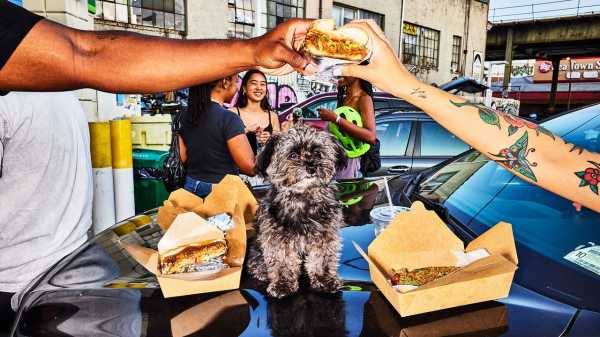
Save this storySave this storySave this storySave this storyYou’re reading the Food Scene newsletter, Helen Rosner’s guide to what, where, and how to eat. Sign up to receive it in your in-box.
The shiny BP gas station that occupies the triangle where Myrtle and Grove Streets intersect, in Bushwick, is not a terribly charming feature of our urban landscape. The North Brooklyn neighborhood is known for its friendly, lived-in grit—music spilling out of coffee shops and electronics stores, swoops of street art on brick walls and security gates, the M train’s elevated tracks running down Myrtle like an industrial-age colonnade. BP, one of America’s largest refuelling chains, with its green-and-white canopy over the gas pumps, and the bright-white walled convenience store called simply “Shop,” adds a dissonant note of placelessness. It feels wrong to show up here for any reason other than filling up your car; certainly it is not the place you’d think to go for a bite to eat. There’s plenty to be said for gas-station dining, as a concept—barbecue shacks out behind the pumps in Texas, tamales on store-shelf warming racks in Georgia. Closer to home, even the fried chicken at the Flory’s Gas on the Taconic Parkway has its virtues. But, in New York City, land of bodegas and corner delis, to find your meal at a branded gas-station convenience store verges on the perverse.
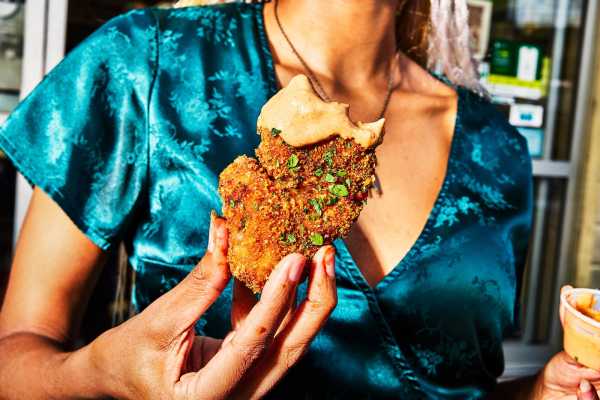
The “chicken tendies” comprise three craggy specimens for nine dollars.

The owners have said they wanted to “halalify” cheap, satisfying food for Bushwick’s night-owl crowds.
And yet, into “Shop” I recently went—more than once, in fact—because a few months ago a portion of the space, formerly an unremarkable fried-chicken counter, became a new short-order joint called Blue Hour. It is run by a quartet that includes Ali Zaman—who operates the Afghan stalwarts Little Flower and Sami’s, both in Queens—and Mohamed Ghiasi, of Brooklyn’s terrific Afghan restaurant Dunya Kabab House. Where those restaurants embrace a warm, soft aesthetic, Blue Hour has the fluorescent freneticism of a late-night stoner takeout spot, which is pretty much exactly what it is. The wall-size, backlit, all-photographic menu reads like a fast-food greatest-hits album: a smashburger, a chopped cheese, a hot chicken sandwich, a Cwunch Wap Supweme [sic] modelled on the iconic Taco Bell assemblage. The duo have said that they wanted to “halalify” this kind of cheap, satisfying cuisine for Bushwick’s night-owl crowds—it’s the kind of food that hits extra hard when the clock rounds the curve from late night into early morning, and the lights of a twenty-four-hour gas station shine like a beacon in the dark. (Blue Hour is open until 3 A.M. on weekends; on school nights they close at ten o’clock. Everything is, indeed, halal, and nothing on the menu costs more than twelve dollars.)
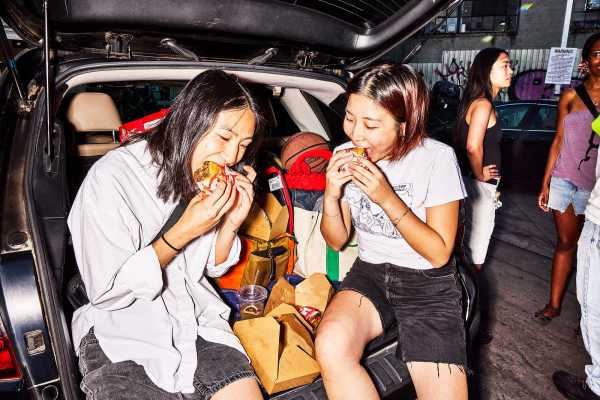
The menu includes a chopped cheese, a smashburger, and street-cart-style chicken over rice.
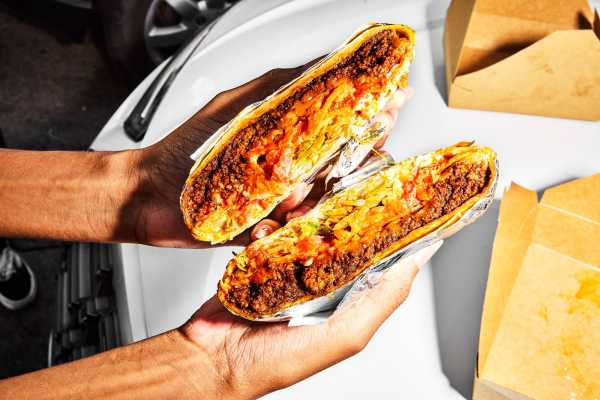
The Cwunch Wap Supweme [sic] is modelled on the iconic Taco Bell assemblage.
The food at Blue Hour is made with high-quality ingredients and a considerable amount of care. The star of the show is undoubtedly the Cwunch Wap Supweme, with its spiced beef and assorted taco-ish fillings—diced tomato, iceberg lettuce, shredded cheese, homemade queso, sour cream—layered above and below a crisp tostada round, then wrapped up inside an oversized soft tortilla. It’s a familiar shape, but the flavors are far more nuanced than those of its mega-chain counterpart: the tortilla tastes fresh and chewy; the seasonings have warmth and depth and a glowing, peppery heat. The hot-chicken sandwich, dubbed the Dragon Boy, reaches a more serious level of spiciness; the meat is craggy, crisp-fried, and drenched in a wicked and intensely floral triple-chile hot sauce. It’s piled on a squishy potato roll with pickles and a purple-cabbage slaw. One of the downsides of the huge, exciting picture menu is that it’s a real beast to edit when the menu changes, as it inevitably does when a young restaurant is figuring out its deal. I learned that the Loco Moco (the kingly Hawaiian combo of a seasoned burger patty, fried eggs, and mushroom gravy over white rice) got cut from the lineup before I could try it, and that a chicken-parm sandwich I’d thought was pretty solid had been replaced by a different chicken-cutlet sandwich, the Crown Jewel, which includes thin slices of fried eggplant on an Italian roll, with fresh basil, fresh mozz, and a drizzle of balsamic vinegar. It’s subtle and fresh-tasting, a delicious odd duck among dishes that otherwise relentlessly wallop you with flavor.
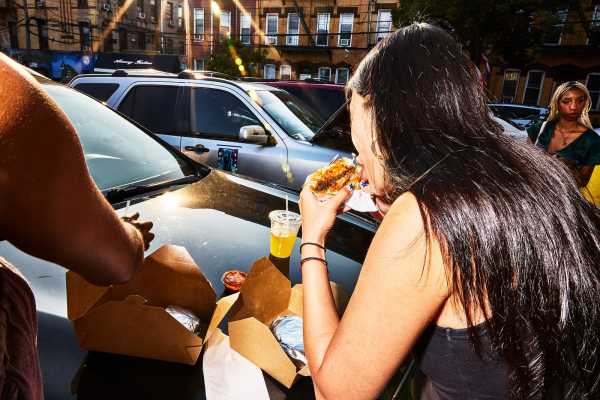
There are no seats inside the shop, but it’s easy enough to make do.
Helen, Help Me!
E-mail your questions about dining, eating, and anything food-related, and Helen may respond in a future newsletter.
The scene inside the BP station varies pretty widely depending on the time of day. In the lulls between the lunchtime and late-night rushes, the space has the sort of uncanny near-emptiness that’s specific to places that are both overly sanitized and slightly run-down. There are crumpled tickets on the lottery counter, off-brand toys on the shelves, rows of chips and cookies washed out by fluorescent lights. But show up when Blue Hour is hopping and it’s a scene, packed with overspill from nearby parties and crowds of delivery drivers. Everyone is waiting for cardboard takeout containers of smashburgers (juicy and cheesy, fantastically lacy around the edges) or chopped cheeses (a smushy, savory mess, just as it should be, on a satisfyingly crusty roll from Parisi Bakery, in Queens), or a big pile of street-cart-style chicken and rice doused in white sauce—a family recipe—and more zingy dragon sauce. There’s nowhere to sit and eat, but it’s easy to make do: prop your food on the hood of a car, walk a couple blocks till you find a convenient stoop to sit on, or hop on the train and eat your Cwunch Wap at home. It’s no problem; it’s food designed to travel. Who wants to hang around at a gas station, anyway? ♦
Sourse: newyorker.com